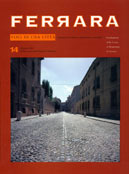Joseph Mazzuoli called Bastarolo
(Ferrara 1536 -1598)
St. Agatha and St. Lucia
The two saints elegantly share the scene. With a humble and pious gesture, St. Agatha carries her cut off breasts on a tray, which is the sign of her martyrdom. St. Lucia holds a disquieting flower, whose petals are formed by eyes, in her right hand, as an iconographical symbol.
Painting easy and accessible religiousness is typical of the last paintings by Bastarolo, who follows the rules of Counter Reformation.
Peter Damini
(Castelfranco Veneto 1592- Padua 1531)
Our Lady is on the throne between St. Francis and St. Margaret (?)
The painting depicts Our Lady who gives Infant Jesus to St. Francis and the elegant saint, who is probably Saint Margaret for the monstrous dragon which, after having been tamed, is sleeping at her feet, representing her traditional iconographical symbol. Our Lady's bare foot, which is destined to crush the snake, which is Satan's symbol according to Apocalyptic vision, refers to the complex article of faith related to Immaculate Conception. The theme, which has been developed thanks to clear, simple and comprehensible painting techniques, accurately and consciously follows Counter Reformation theoretical rules. The work is ascribed to Peter Damini. In fact, the enhanced colour tone and saint elegance are typical of an artist who is famous for the diffusion of the great Venetian tradition.
Master of the Twelve Apostles
Jacob and Rachel near the well
The subject of the painting is taken from an episode of the Old Testament: Jacob, who is surrounded by three shepherds, is removing the stone from the well to water Labano's sheep. Rachel, Labano's daughter, is standing on the right, acting as a shepherd lass. Fantastic elements, castles and blue mountains which appear on the horizon serve as a background to other episodes which are taken from the Bible: in the middle, Labano, his wife and his daughter, Leah, move away from the town, on the left, Jacob is performing one of the tasks required by Labano.
The event takes place as if it were a pastoral scene, where Labano's flock is in the background, while an odd assortment of animals, which are accurately described, and other details, such as a bag of fruit and a bagpipe which is left on the ground, are in the foreground. Thanks to the foreground and clear painting techniques, these elements stand out as if they were a still life. The work reflects the style of the members of the Este family in the first half of the sixteenth century, with northern painting descriptive details and Flemish painters clarity.
Benvenuto Tisi, il Garofalo (Ferrara 1481? - 1559)
Our Lady with Infant Jesus and St. Joseph
The Holy Family is depicted in a wide and quiet landscape: Our Lady holds Infant Jesus who is standing naked; St. Joseph is at her side, lying down, leaning on a stick. They probably take a rest during the Flight into Egypt. A river landscape with castles and blue mountains in the distance, in a stormy sky, stands out, while people seek shelter under a tree with gold-highlighted leaves. The enchanted and quiet landscape seems to protect the peaceful moment shared by the people in the foreground: the holy scene is deeply immersed in nature. The sense of total immersion in the landscape, which can also be found in other Garofalo's works, was shared by another artist, Dosso Dossi, who was employed in Ferrara in the first half of the XVIth century, inducing us to think that this work was made in a period of stylistic analogies between the two painters.



